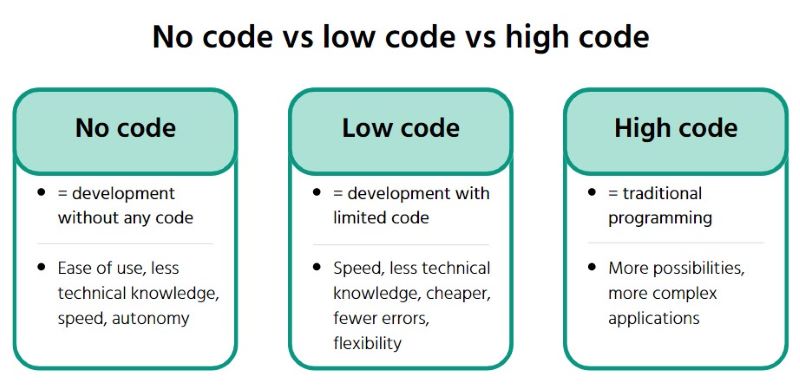No code, low code or high code: which is the best choice?
No code, low code, and high code are terms that refer to techniques for designing and developing apps. Nowadays, more and more organizations are opting for no code or low code-based applications instead of traditional software packages. But what do these forms of code mean, and which one should your team choose? In this blog, we provide you with all the information you need to make the right choice.
No code platforms
As the name suggests, with a no code platform, you can develop applications without using any code. This means that even employees without programming knowledge can easily create a simple application. Often, these platforms have pre-defined templates that you can use, and you can also easily add or drag and drop elements to different positions. In other words, no code platforms enable software development using drag-and-drop tools.
Benefits of no code
- Easy to use. Since you don't need any programming knowledge to use no code platforms, they are quite user-friendly. The use of no code is highly accessible to everyone due to templates and drag-and-drop features.
- Reduced dependency on technical expertise. Due to the ease of use, your project can continue independently of technical knowledge. This saves you time and costs. The technical team can also focus more on projects with higher priority.
- Quickly turn your ideas into real projects. Without the need for technical knowledge to program the software itself, you can bring your ideas to life quickly. You no longer need to spend time explaining your vision. You can start working on the application yourself and develop it as you envision.
- Increased autonomy. By developing your applications with a no code platform, you have the opportunity to fully understand the application. You become the owner of these various tools and systems, which can be a significant advantage for growing businesses.
No code, low code, and high code are terms that refer to techniques for designing and developing apps. Nowadays, more and more organizations are opting for no code or low code-based applications instead of traditional software packages. But what do these forms of code mean, and which one should your team choose? In this blog, we provide you with all the information you need to make the right choice.
Low code platforms
To use low code, you need slightly more technical knowledge than with no code, although it is still limited. Similar to no code, it often involves graphical tools with drag-and-drop functionality. As the amount of manual coding remains low, the development of certain applications becomes simpler. As a result, developers can focus more on the design and functionality of the application. Although some coding is involved, you can develop more complex applications with low code.
Benefits of low code
- Faster development. With low code platforms, you can also benefit from pre-defined templates and components, making development much faster and easier. Adjustments due to changing circumstances can also be launched more quickly.
- Less technical knowledge required. Similar to no code, you require significantly less technical knowledge. The interface is highly visual, allowing you to make modifications easily without the assistance of a programmer.
- Cost savings. Thanks to the accelerated development process and the reduced need for highly skilled programmers, your company can save costs.
- More flexibility. Low code is a significant advantage for companies with constantly changing business needs. Due to the visual interface and the small amount of code, adjustments can be made much faster and easier.
- Reduced errors. With high code, there is a greater chance of errors. Even the smallest errors can cause problems, and it can sometimes be challenging to identify and fix those errors. With low code, you have a much lower chance of errors, saving time once again.
High code platforms
High code platforms are essentially synonymous with traditional programming. In this approach, an experienced programmer starts from scratch and develops applications and software through full coding. To use high code, you need substantial technical knowledge and familiarity with programming languages and techniques. With high code, you can develop much more complex applications that may not be possible with no code or low code.
Benefits of high code
- Greater possibilities: With more complex and extensive coding, applications can be fully customized to specific needs and requirements. High code allows you to develop a completely unique application tailored to your company and vision.
- Complex applications: High code enables handling complex tasks that may have limitations with no code and low code. You can work with intricate formulas and data using high code.

Making the Best Choice: No code, Low code, or High code
Now that you understand the differences and benefits of no code, low code, and high code, you may be wondering which platform is the best choice. However, there is no one-size-fits-all answer to that question. The most suitable system for your company and specific situation depends on various factors. Here are some indicators to consider when making your choice.
1. Expertise
As mentioned above, each type of platform requires a different level of expertise. Visual programming in no code and low code platforms, with features like drag-and-drop, requires little to no expertise. However, this comes with certain limitations. High code allows you to do much more, but it requires the necessary expertise.
2. Flexibility
If it's crucial for your company that your application is flexible, it's best to choose low code or high code. Low code may have slightly more limited flexibility and capabilities, but it requires less technical knowledge. If you have experienced developers on your team, you can opt for high code. With their programming skills combined with a wide range of possibilities, high code remains the most flexible.
3. Speed
Speed also plays a significant role, referring to how long it takes to develop an application using different platforms. Developing an application with high code generally takes the longest. Coding requires a considerable amount of time, especially for complex applications. Low code and no code require much less time.
4. Purpose
Finally, the purpose for which the application is needed is a crucial factor. For simple applications or formulas, no code is sufficient. But if you require more complex applications, no code is too limited. That's where low code and high code are much better suited.
Best of all worlds: A Hybrid System of No code, Low code, and High code
Instead of choosing just one system, you can also opt for building a hybrid system that combines no code, low code, and high code. Such a hybrid system not only provides your team with more possibilities but also saves time. Developers can focus entirely on the functionality of the application or software with their technical knowledge, while other team members can concentrate more on layout and the visual aspect of the content. No code and low code effectively support high code, giving the technical team more time and space for innovation.
If you're looking for a customized application that is easy to manage and considering a no code or low code approach after reading this blog, Quivvy Solutions has the solution for your company. See what we can do in our portfolio or contact us.

